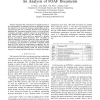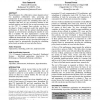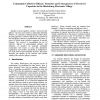974 search results - page 104 / 195 » Social Networks in Peer-to-Peer Systems |
HICSS
2005
IEEE
14 years 2 months ago
2005
IEEE
— Semantic Web researchers have initially focused on the representation, development and use of ontologies but paid less attention to the social and structural relationships invo...
CSCW
2011
ACM
13 years 3 months ago
2011
ACM
The performance of a collaborative system depends on how two mandatory collaborative tasks, processing and transmission of user commands, are scheduled. We have developed multiple...
IJNSEC
2006
13 years 9 months ago
2006
Within the area of criminal and terrorist social network analysis, there is little research being done on analysing the communication behavior of criminal and terrorist groups. In...
CHI
2008
ACM
14 years 9 months ago
2008
ACM
This dissertation research explores the invocation of emotional support from friends and family for parents who have a baby in a Neonatal Intensive Care Unit, through the use of t...
HICSS
2003
IEEE
14 years 2 months ago
2003
IEEE
Bandura’s social cognitive construct “perceived selfefficacy” has been used widely to understand individual behavior as a function of domain-specific beliefs about personal ...



